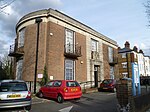East Finchley tube station

East Finchley is a London Underground station in East Finchley in the London Borough of Barnet, north London. The station is on the High Barnet branch of the Northern line, between Finchley Central and Highgate stations, and is in Travelcard Zone 3. The station was opened on 22 August 1867, on the Great Northern Railway's line between Finsbury Park and Edgware stations. As part of London Underground's only partially completed Northern Heights plan, the station was completely rebuilt with additional tracks in the late 1930s. Northern line trains started serving the station on 3 July 1939 and main line passenger services ended on 2 March 1941.
Excerpt from the Wikipedia article East Finchley tube station (License: CC BY-SA 3.0, Authors, Images).East Finchley tube station
The Causeway, London Hampstead Garden Suburb (London Borough of Barnet)
Geographical coordinates (GPS) Address Nearby Places Show on map
Geographical coordinates (GPS)
| Latitude | Longitude |
|---|---|
| N 51.587222222222 ° | E -0.165 ° |
Address
The Causeway
N2 0GA London, Hampstead Garden Suburb (London Borough of Barnet)
England, United Kingdom
Open on Google Maps










